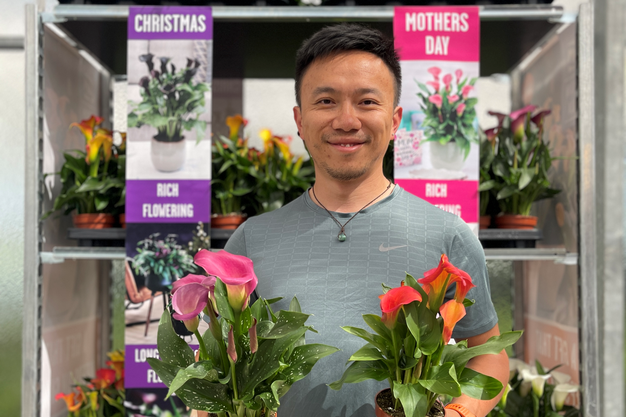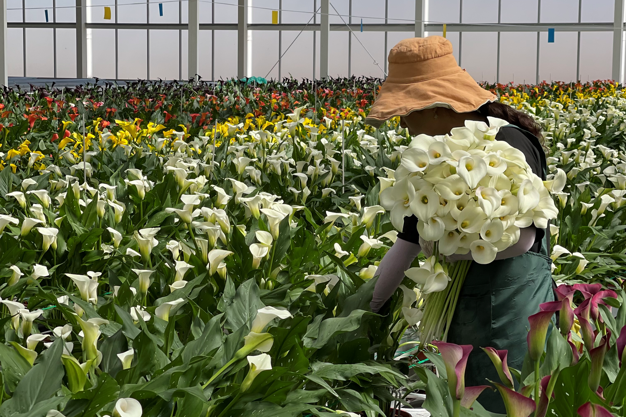"Calla is definitely not an easy flower to grow, it requires passion, knowledge, and patience. In China many growers want to get immediate profits by investing minimum efforts or knowledge, this doesn't work on callas," says Shurui Zhang of Kunming Caima Horticulture Co., Ltd (KCH). He and his business partner Wayne grow and promote Captain Callas, calla lily varieties from Dutch calla breeder Kapteyn to Chinese growers. In this article, he tells more about his journey from a horticulture student towards becoming the exclusive partner of Kapiteyn in China. He also discusses the development of KCH, that was established more than a decade ago, and the chances and challenges of the Chinese calla market.

From left to right: Wayne, Bo Schilder (Account Manager at Kapiteyn), and Shurui Zhang during an open day at Kapiteyn in June 2023.
Coincidence
Zhang points out that promoting Captain Callas was far from planned. "It was pure coincidence that I got acquainted with Kapteyn. In 2008, I went to the Netherlands to study International Horticulture and Marketing at Van Hall Larenstein in Wageningen, the Netherlands. During the introduction week, I met Lenn Kapiteijn, that's how we were connected with each other," he says. After graduation, Zhang started his career at a Dutch lily breeding company, where he was introduced to Kapiteyn. "Since my previous boss would like to develop the Chinese calla market he introduced me to Kapiteyn, again a coincidence. In 2010, I started working at Kapiteyn and that was the first moment that I got to know about callas. I was amazed by their unique beauty, elegance, and versatility as ornamental plants. In 2012, I went back to China and started promoting Captain Calla varieties to Chinese growers."

Risks and successes
Back in China Zhang and Wayne started to grow callas, he explains why. "In the beginning, it was quite challenging to promote callas to local growers: callas were not popular among Chinese consumers, and there was only one local grower who offered a limited range in limited quantities. Moreover, calla cultivation comes along with high tuber prices and high cultivation risks. We decided to start growing callas ourselves to provide Chinese growers with cultivation tips and to select varieties that are suitable for the Chinese market. As a result, we founded KCH in 2013. We tested all the varieties from Kapiteyn, and we showed them to growers and wholesalers when they were flowering. In 2014, we launched the first pot callas in the Chinese market, and they were well received. Many consumers and wholesalers were not aware that there were so many different calla colors aside from white and yellow. They also appreciated the long vase life of Captain Calla varieties). Nowadays, our varieties, such as Captain Solo, Captain Cheerio, and Captain Ventura, are quite famous among Chinese calla growers. That's how we became Kapteyn's exclusive partner in China."

Zhang highlights that the Chinese calla market has advanced over the past decade, he illustrates: "At this moment, there are about 1.2 million pot callas planted in China. The peak was in 2019, with almost 2 million pots. The highest cut calla yield is expected this year, currently, there are about 3 million cut callas produced in China. Currently, Chinese growers grow about 4-5 hectares of pot callas and 2-3 hectares of cut callas (including the small seasonal family growers). In 2020, KCH fully stopped pot calla cultivation because 95% of our customers are pot calla growers, and all of them are well educated for growing pot callas. There was no need to keep on growing pot callas at KCH. I'd say our strategy has been successful till now. Part of our strategy is that we were strict in selecting our growers. Before we sell our tubers, we always talk to our customers and visit them. Also, after selling, the ongoing services are important. I still remember our first customer, Kunming Trifecta. I was stationed at their greenhouse for almost half a year to make sure everything was done correctly. Now Kunming Trifecta is our biggest customer and also the biggest pot calla grower in China."

Callas are being harvested in the KCH greenhouse in China.
Exploring new cut calla markets
All those years KCH has been facing the challenges of calla cultivation in China. "Calla is a crop with high profits but also very high risks in China. Aside from the tuber quality, the climate and irrigation control in the greenhouse is very essential. When you make a small mistake, it can cause really big losses for calla growers. Thankfully, Kapiteyn has made a lot of significant improvements and renovations on the calla field. They overcame the difficulties of quality loss during long storage, and they introduced a lot of really strong varieties, including Captain Solo, Captain Cheerio, Captain Hollywood, and Captain Miro. The most important thing is that Kapiteyn has really strict tuber quality inspection standards to make sure the growers receive high-quality tubers. That's the first guarantee of successful cultivation," Zhang elaborates. He adds that they are also confronted with a changing economy. "The COVID-19 pandemic negatively affected the Chinese economy, resulting in a decrease in the pot flower market. We don't expect the Chinese pot calla market will expand in the coming 2-3 years."
In light of these challenges, KCH is exploring ways to expand its business to neighboring countries. "At the moment, we only sell pot and cut callas in China. However, we think that there are opportunities for the export of cut callas. We think of countries such as Japan and Singapore. As well as Vietnam, in March, we attended the Hortex fair to see if there are any business opportunities in Vietnam. KCH might double the cut calla production if the international market is well developed in the coming years. But as mentioned before, calla is very risky, we still have to carefully investigate before the expansion," Zhang concludes.
For more information:
Shurui Zhang
Kunming Caima Horticulture
Email: [email protected]
